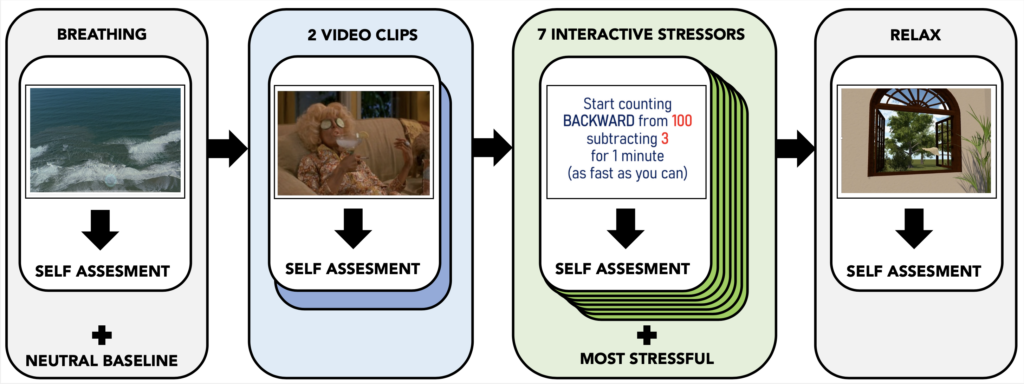
The experimental protocol consists of 11 tasks separated by self-assessments and grouped into 4 blocks: guided breathing, watching emotional video-clips, a sequence of interactive tasks (1min), and a relaxation phase.
Overview of the recording framework with the main 4 blocks.
The tasks have been designed to elicit 3 different categories of responses; 1) stimulate the audiovisual cortex of the participants, 2) increase the cognitive load by soliciting attention, comprehension, mental arithmetic or multi-tasking abilities, and 3) elicit psycho-social stress leveraging on public speaking as a stressor.
Each task is identified in the Dataset by subjectname_task.
The exact text of instructions received by the subjects for each task are given below:
- Breathing: “Now breathe deeply and relax”. This task aims to relax and reset to neutral the emotional state of the subjects. This recording is used as a baseline for not-verbal neutral state.
- Video1: “Watch the video”. The first video is an extract from the movie There’s something about Mary, selected to elicit low arousal and positive valence in the participants.
- Video2: “Watch the video”. The second video is an extract from the movie Indiana Jones and the Last Crusade, selected to elicit high arousal and negative valence.
- Counting1: “Start counting backwards from 100 subtracting 3 for 1 minute (as fast as you can)”. This is a Mental Arithmetic Tasks (MAT) designed to increase the participant’s cognitive load through arithmetic operations.
- Counting2: “Start counting backwards from 1011 subtracting 7 for 1 minute (as fast as you can)”. This task is another MAT of increased difficulty.
- Stroop: “Say out lout as many font colors as you can in one minute”. The task is a variant of the Stroop Color-Word Test, selected to increase the cognitive load by soliciting the attention and reactivity of the participants.
- Speaking: “Explain what are your strengths and weaknesses in 1 minute”. This task is a Social Evaluative Task (SET), leveraging public speaking as a social stressor.
- Math: “Answer to the following mental arithmetic question in 1 minute”. This is a task designed to increase the mental workload. The participants are asked to resolve 20 mathematical problems in one minute.
- Reading: “Read the following text in 1 minute (you can read silently)”, followed by; “Explain the text in details to us in 1 minute”. This is a task composed of 2 phases and designed as a TSST variation. Participants have to read a text, in a first step, and then explain what they read, in the next step, thus simultaneously soliciting comprehension abilities and using speaking as a stressor.
- Counting3: “Start counting backwards from 1152 subtracting 3 for 1 minute while touching your thumb with your other fingers”. This taks is a a MAT with added difficulty. Participants are instructed to count backwards from 1152 subtracting 3, as fast as they can, while repeating an independent hand movement. This task is designed to increase the mental workload by soliciting participants’ multi-tasking abilities.
- Relax: “Watch the relaxing video”. This is the last task of the experimental protocol. It consists of a 5 minutes relaxation, where the participants are instructed to watch a relaxing video


